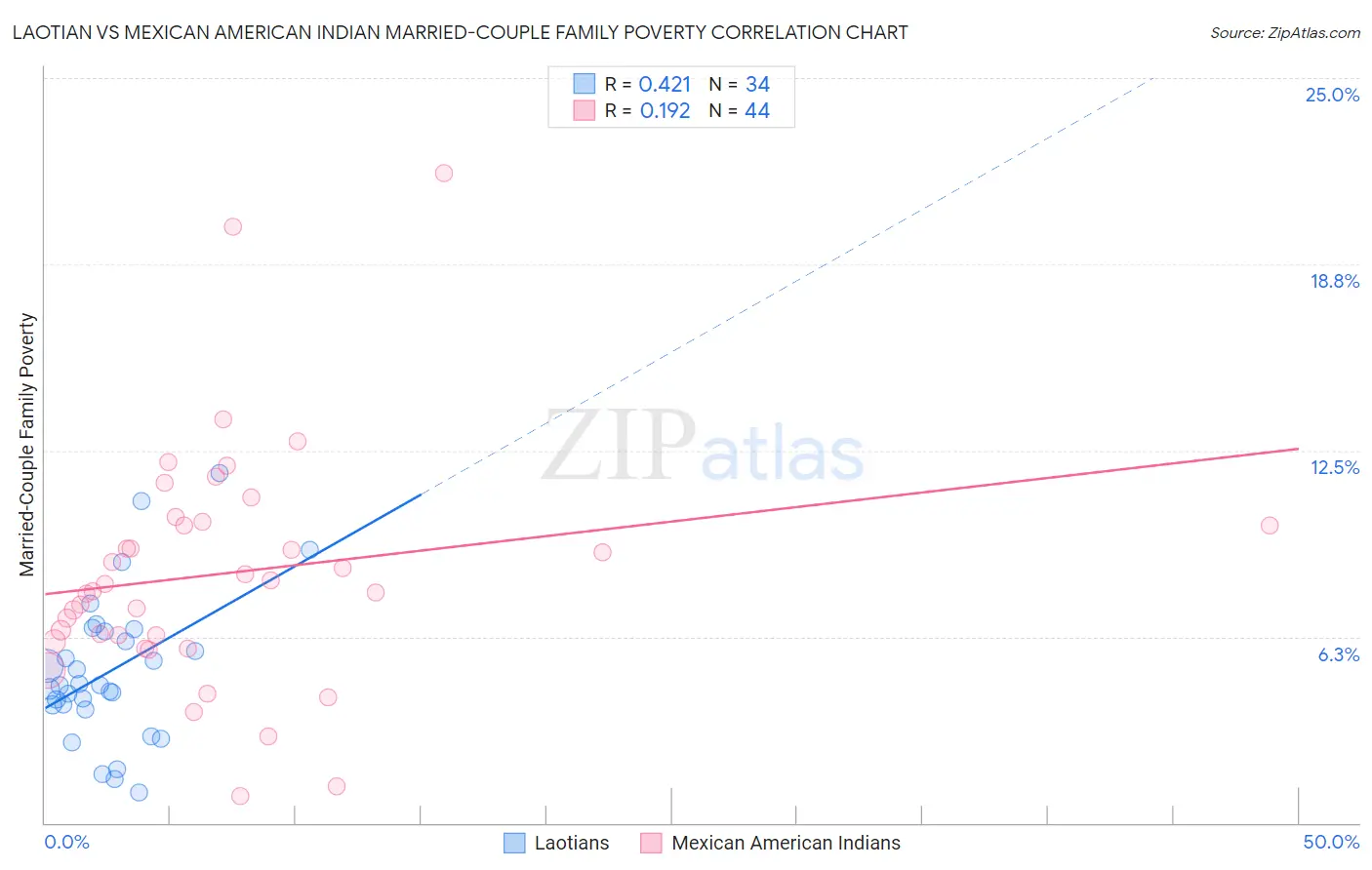Laotian vs Mexican American Indian Married-Couple Family Poverty
COMPARE
Laotian
Mexican American Indian
Married-Couple Family Poverty
Married-Couple Family Poverty Comparison
Laotians
Mexican American Indians
4.7%
MARRIED-COUPLE FAMILY POVERTY
96.6/ 100
METRIC RATING
108th/ 347
METRIC RANK
6.4%
MARRIED-COUPLE FAMILY POVERTY
0.0/ 100
METRIC RATING
281st/ 347
METRIC RANK
Laotian vs Mexican American Indian Married-Couple Family Poverty Correlation Chart
The statistical analysis conducted on geographies consisting of 223,838,659 people shows a moderate positive correlation between the proportion of Laotians and poverty level among married-couple families in the United States with a correlation coefficient (R) of 0.421 and weighted average of 4.7%. Similarly, the statistical analysis conducted on geographies consisting of 316,454,269 people shows a poor positive correlation between the proportion of Mexican American Indians and poverty level among married-couple families in the United States with a correlation coefficient (R) of 0.192 and weighted average of 6.4%, a difference of 36.1%.

Married-Couple Family Poverty Correlation Summary
| Measurement | Laotian | Mexican American Indian |
| Minimum | 1.0% | 0.88% |
| Maximum | 11.7% | 21.8% |
| Range | 10.7% | 20.9% |
| Mean | 5.1% | 8.4% |
| Median | 4.6% | 7.9% |
| Interquartile 25% (IQ1) | 4.0% | 6.2% |
| Interquartile 75% (IQ3) | 6.4% | 10.0% |
| Interquartile Range (IQR) | 2.5% | 3.9% |
| Standard Deviation (Sample) | 2.5% | 4.0% |
| Standard Deviation (Population) | 2.4% | 3.9% |
Similar Demographics by Married-Couple Family Poverty
Demographics Similar to Laotians by Married-Couple Family Poverty
In terms of married-couple family poverty, the demographic groups most similar to Laotians are Immigrants from Hong Kong (4.7%, a difference of 0.20%), Immigrants from Germany (4.7%, a difference of 0.26%), Immigrants from France (4.7%, a difference of 0.27%), Immigrants from Bolivia (4.7%, a difference of 0.36%), and Pakistani (4.7%, a difference of 0.40%).
| Demographics | Rating | Rank | Married-Couple Family Poverty |
| Yugoslavians | 97.8 /100 | #101 | Exceptional 4.6% |
| Asians | 97.6 /100 | #102 | Exceptional 4.7% |
| Immigrants | Romania | 97.3 /100 | #103 | Exceptional 4.7% |
| Immigrants | Moldova | 97.1 /100 | #104 | Exceptional 4.7% |
| Aleuts | 97.0 /100 | #105 | Exceptional 4.7% |
| Immigrants | France | 96.9 /100 | #106 | Exceptional 4.7% |
| Immigrants | Germany | 96.8 /100 | #107 | Exceptional 4.7% |
| Laotians | 96.6 /100 | #108 | Exceptional 4.7% |
| Immigrants | Hong Kong | 96.4 /100 | #109 | Exceptional 4.7% |
| Immigrants | Bolivia | 96.2 /100 | #110 | Exceptional 4.7% |
| Pakistanis | 96.2 /100 | #111 | Exceptional 4.7% |
| Tongans | 95.9 /100 | #112 | Exceptional 4.7% |
| Immigrants | Nepal | 95.9 /100 | #113 | Exceptional 4.7% |
| Immigrants | Indonesia | 95.1 /100 | #114 | Exceptional 4.8% |
| Taiwanese | 94.8 /100 | #115 | Exceptional 4.8% |
Demographics Similar to Mexican American Indians by Married-Couple Family Poverty
In terms of married-couple family poverty, the demographic groups most similar to Mexican American Indians are Seminole (6.4%, a difference of 0.0%), Ute (6.4%, a difference of 0.39%), Dutch West Indian (6.4%, a difference of 0.50%), West Indian (6.4%, a difference of 0.51%), and Houma (6.4%, a difference of 0.56%).
| Demographics | Rating | Rank | Married-Couple Family Poverty |
| Barbadians | 0.1 /100 | #274 | Tragic 6.3% |
| Choctaw | 0.1 /100 | #275 | Tragic 6.3% |
| Yaqui | 0.1 /100 | #276 | Tragic 6.3% |
| Indonesians | 0.1 /100 | #277 | Tragic 6.3% |
| Immigrants | Trinidad and Tobago | 0.1 /100 | #278 | Tragic 6.4% |
| Houma | 0.0 /100 | #279 | Tragic 6.4% |
| West Indians | 0.0 /100 | #280 | Tragic 6.4% |
| Mexican American Indians | 0.0 /100 | #281 | Tragic 6.4% |
| Seminole | 0.0 /100 | #282 | Tragic 6.4% |
| Ute | 0.0 /100 | #283 | Tragic 6.4% |
| Dutch West Indians | 0.0 /100 | #284 | Tragic 6.4% |
| Blacks/African Americans | 0.0 /100 | #285 | Tragic 6.5% |
| Guyanese | 0.0 /100 | #286 | Tragic 6.5% |
| Ecuadorians | 0.0 /100 | #287 | Tragic 6.5% |
| Salvadorans | 0.0 /100 | #288 | Tragic 6.5% |